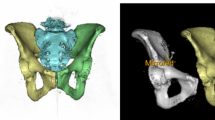Abstract
Understanding bilateral pelvic symmetry can be useful for analyzing complex pelvis anatomy and simplifying difficult procedures for pelvic fractures. This paper aims to quantify the degree of regional pelvic symmetry using computer-based methods. CT scans of 30 intact pelvises were digitized into 3D models and regions were defined: the ilium, acetabulum, pubis, and ischium. The right hemipelvis was aligned with the left, and deviations between the two models were quantified using method 1 (global registration) and method 2 (local registration). Symmetry was evaluated using the root mean square (RMS) of the deviations and the percentage of points within preset thresholds of ± 2 mm and ± 1 mm. The results showed that > 86% of points are within the ± 2 mm deviation threshold and average RMS are < 1.33 mm. For all regions, method 2 showed lower deviations than method 1. The pubis and ischium regions showed a large difference in symmetry between the two methods indicating high local symmetry, but a degree of global asymmetry. Conversely, the acetabular and iliac regions showed similar levels of symmetry with the two methods. When evaluated locally, the pelvic regions can be considered highly symmetric; the acetabulum is highly symmetric globally as well. These findings can be used in future studies to assess the feasibility of patient-specific implants using the mirrored contralateral hemipelvis as a template for unilateral pelvic fracture fixation.
Graphical abstract

The left image shows the “cut planes” used to define four pelvic regions: the ilium, acetabulum, pubis, and ischium. The right image shows a deviation color map (DCM) used to quantify bilateral pelvic symmetry. The scale and color illustrate the degree of deviation of the left hemipelvis with the right hemipelvis with the units in millimeters (mm).










Similar content being viewed by others
References
Maini L et al (2018) Evaluation of accuracy of virtual surgical planning for patient-specific pre-contoured plate in acetabular fracture fixation. Arch. Orthop. Trauma Surg. 138(4):495–504. https://doi.org/10.1007/s00402-018-2868-2
Ead MS et al (2020) Investigation of pelvic symmetry using CAD software. Med. Biol. Eng. Comput. 58(1):75–82
Osterhoff G et al (2019) Symmetry matching of the medial acetabular surface—a quantitative analysis in view of patient-specific implants. J. Orthop. Trauma 33(3):e79–e83
Lee P et al (2012) Virtual 3D planning of pelvic fracture reduction and implant placement. Biomed. Eng. Appl. Basis Commun. 24(03):245–262. https://doi.org/10.4015/S101623721250007X
Hernandez D et al (2017) Computer-assisted orthopaedic surgery. Orthop Surg 9(2):152–158. https://doi.org/10.1111/os.12323
Cimerman M, Kristan A (2007) Preoperative planning in pelvic and acetabular surgery: the value of advanced computerised planning modules. Injury 38(4):442–449
Zeng C et al (2016) A combination of three-dimensional printing and computer-assisted virtual surgical procedure for preoperative planning of acetabular fracture reduction. Injury 47(10):2223–2227
Wang G et al (2016) Computer-assisted virtual preoperative planning in orthopedic surgery for acetabular fractures based on actual computed tomography data. Null 21(1):160–165. https://doi.org/10.1080/24699322.2016.1240235
Ead MS et al (2020) Virtual reconstruction of unilateral pelvic fractures by using pelvic symmetry. International Journal of Computer Assisted Radiology and Surgery 15(8):1267–1277. https://doi.org/10.1007/s11548-020-02140-z
Vignesh U et al (2017) Three dimensional reconstruction of late post traumatic orbital wall defects by customized implants using CAD-CAM, 3D stereolithographic models: a case report. Journal of Oral Biology and Craniofacial Research 7(3):212–218
Islam K et al (2014) Symmetry analysis of talus bone: a geometric morphometric approach. Bone & Joint Research 3(5):139–145
Taniguchi A et al (2015) An alumina ceramic total talar prosthesis for osteonecrosis of the talus. Jbjs 97(16):1348–1353
Upex P, Jouffroy P, Riouallon G (2017) Application of 3D printing for treating fractures of both columns of the acetabulum: benefit of pre-contouring plates on the mirrored healthy pelvis. Orthopaedics & Traumatology: Surgery & Research 103(3):331–334
Boulay C et al (2006) Three-dimensional study of pelvic asymmetry on anatomical specimens and its clinical perspectives. J. Anat. 208(1):21–33
Baclig MM, Westover L, Adeeb S (2019) Categorizing three-dimensional symmetry using reflection, rotoinversion, and translation symmetry. Symmetry 11(9):1132
Hill S et al (2014) Assessing asymmetry using reflection and rotoinversion in biomedical engineering applications. Proc. Inst. Mech. Eng. Part H J. Eng. Med. 228(5):523–529
Cappozzo A et al (1995) Position and orientation in space of bones during movement: anatomical frame definition and determination. Clin. Biomech. 10(4):171–178
Bonneau N et al (2012) Shape variability induced by reassembly of human pelvic bones. Am. J. Phys. Anthropol. 148(1):139–147
Boudissa M et al (2018) Computer assisted surgery in preoperative planning of acetabular fracture surgery: state of the art. Expert Review of Medical Devices 15(1):81–89
Moody ML et al (1992) The effects of fibular and talar displacement on joint contact areas about the ankle. Orthop Rev 21(6):741
E. Letournel and R. Judet, Fractures of the acetabulum. 2012
Betti L (2017) Human variation in pelvic shape and the effects of climate and past population history. Anat Rec 300(4):687–697
Holland EL et al (1982) Associations between pelvic anatomy, height and year of birth of men and women in Belfast. Ann. Hum. Biol. 9(2):113–120. https://doi.org/10.1080/03014468200005581
Acknowledgments
The authors would like to thank Irina Ilic, Sarah McClelland, and Samantha Polege for their assistance in digitization of pelvic models.
Funding
This work was funded by the Natural Sciences and Engineering Research Council of Canada (NSERC).
Author information
Authors and Affiliations
Corresponding author
Ethics declarations
Ethics approval and a waiver of consent were obtained from the Health Research Ethics Board at the University of Alberta.
Conflict of interest
The authors declare that they have no conflict of interest.
Additional information
Publisher’s note
Springer Nature remains neutral with regard to jurisdictional claims in published maps and institutional affiliations.
Glossary of terms
- 3D
-
Three-dimensional
- DCM
-
Deviation color map
- CT
-
Computed tomography
- RMS
-
Root mean square
- POBS
-
Plane of best symmetry
- ASIS
-
Anterior superior iliac spine
- PSIS
-
Posterior superior iliac spine
- AIIS
-
Anterior inferior iliac spine
Rights and permissions
About this article
Cite this article
Li, D.X., Ead, M.S., Duke, K.K. et al. Quantitative analysis of regional specific pelvic symmetry. Med Biol Eng Comput 59, 369–381 (2021). https://doi.org/10.1007/s11517-020-02296-5
Received:
Accepted:
Published:
Issue Date:
DOI: https://doi.org/10.1007/s11517-020-02296-5





